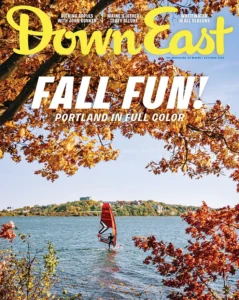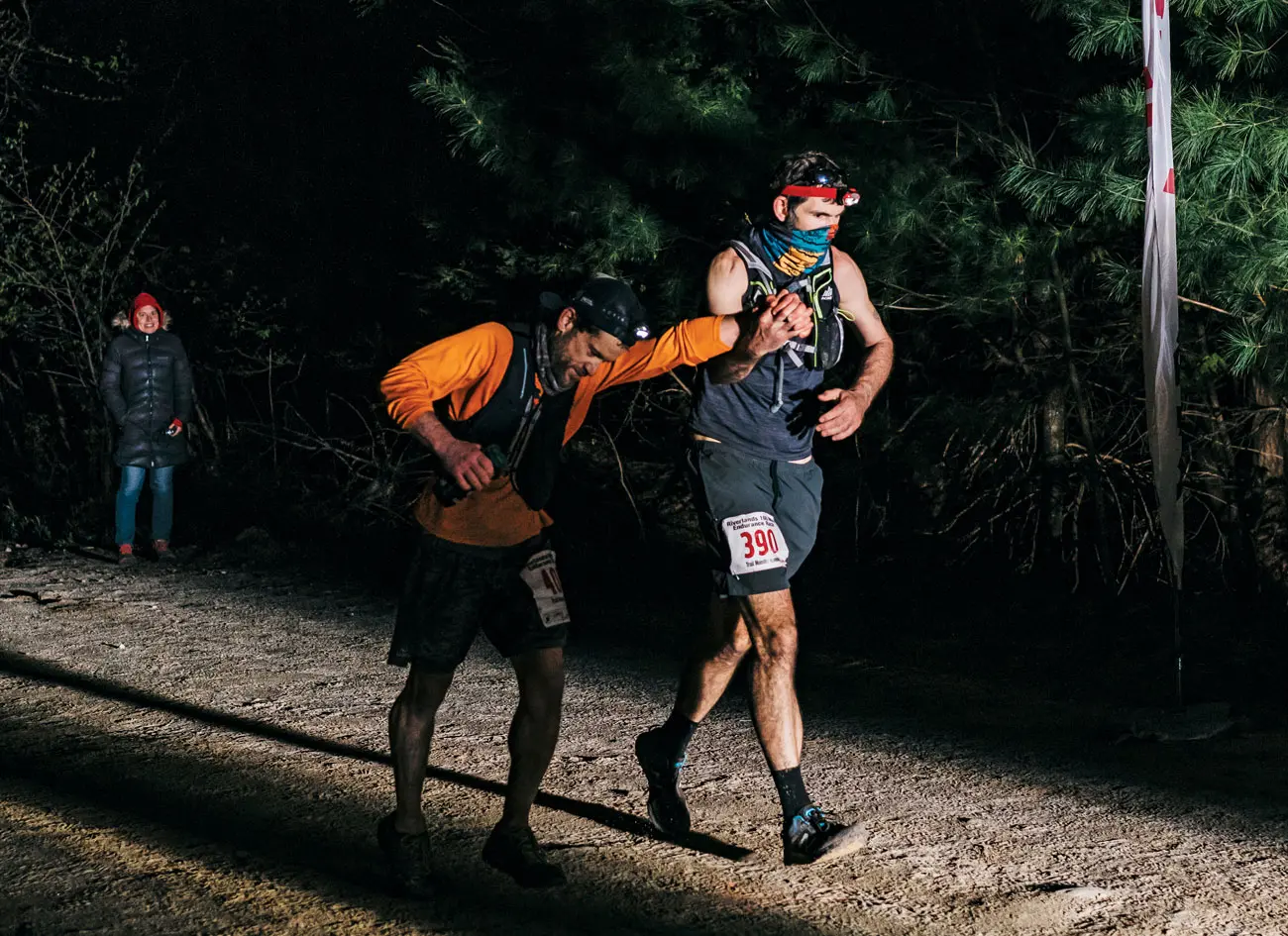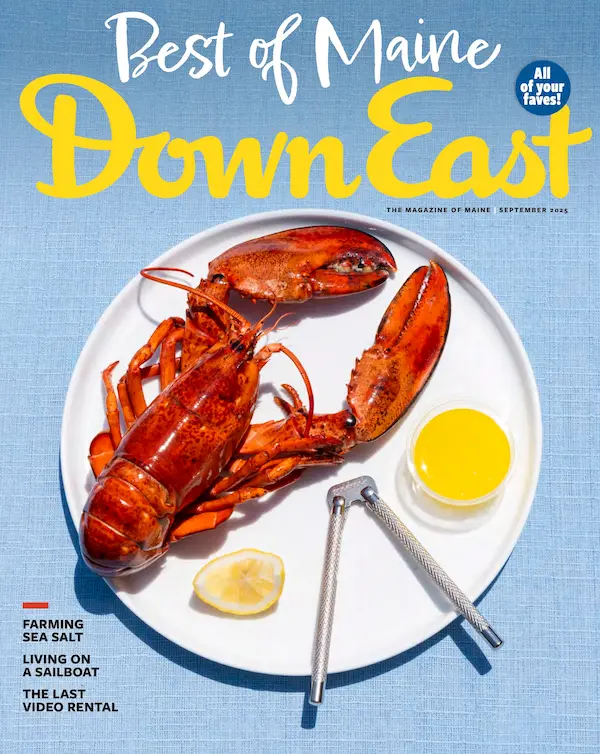By Kathryn Miles
Photos by Ryan David Brown
From our May 2022 issue
In the inky blackness of the Maine woods, even a well-rested mind can play tricks. People become shadows. Shadows begin to seem real. At Androscoggin Riverlands State Park, just outside Turner, some 80 runners are spread out over a punishing 25-mile course. Most have been at it for 24 hours, running that same loop again and again. They’re exhausted, calorie deprived, and very, very sore. The trails they are navigating are rocky, rooty, and uneven — “technical,” in running parlance.
Not far from the river, the course joins a double-track ATV trail. There, just after 2 a.m., a lone runner emerges from the dark, his headlamp the only light. He is middle-aged and whippet lean, wearing black knee-high compression socks, a light backpack containing a hydration bladder, and seemingly enough mud to fill a claw-foot tub. He runs past me without noticing I’m there, muttering incoherently. Then, for no clear reason, he veers off trail, crashing through the understory for 20 yards before stopping with a jolt. He looks around, as if to get his bearings, then slowly returns to the narrow path.
“Guess I fell asleep,” he explains, sheepishly, before continuing down the trail, back into the darkness.
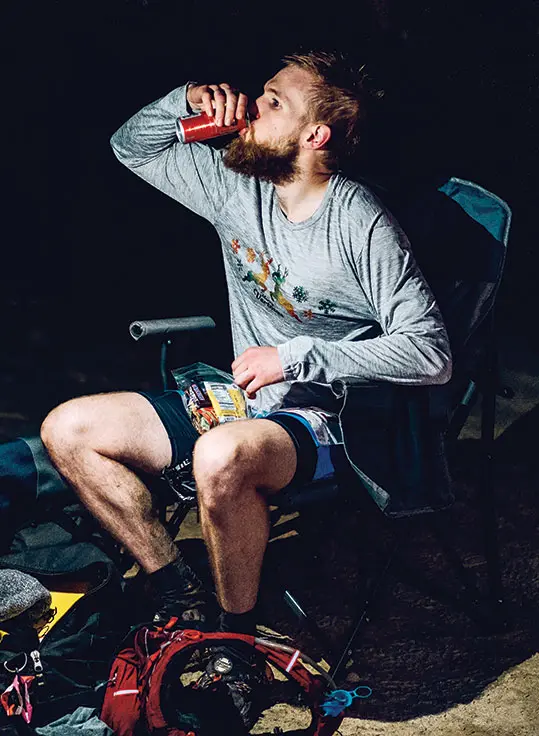

This is the Riverlands 100, Maine’s only 100-mile ultramarathon race, and one of only about 200 such races nationwide. Now in its fifth year, the event attracts runners from as far away as Arizona, Ontario, and Hawaii, each hoping to complete four laps of the undulating, unforgiving course (a 5-person relay option follows a slightly different route). Entrants range in age from their early 20s to late 60s, and about a third are women. Held the second week in May, the race is the brainchild of Valerie Abradi and Mindy Slovinsky, running buddies who met through southern Maine’s Trail Monster Running club and co-directors of several Maine trail races. While training and racing together, they often found themselves lamenting the dearth of 100-mile races here. “We finally decided that if the race was going to happen, it would have to be because of us,” Slovinsky says. “Planning it felt like a way to be of service to the running community.”
When I meet Slovinsky and Abradi in the parking lot of the state park — a combination shanty village, aid station, race headquarters, and starting/finishing line — dawn is still hours away. Support crews and relay-team members huddle around two bonfires, shivering as temperatures drop into the 40s. Nearby, a group of husky men in Carhartt jackets and hunting caps leans against a pair of beefed-up, tricked-out all-terrain vehicles known as side-by-sides. At the center of the lot, a large white tent is illuminated by the ghostly light of LED torches and a portable Coleman stove, around which volunteers are joking and grilling cheese-and-bacon sandwiches and blasting ’80s hair bands from a portable speaker.
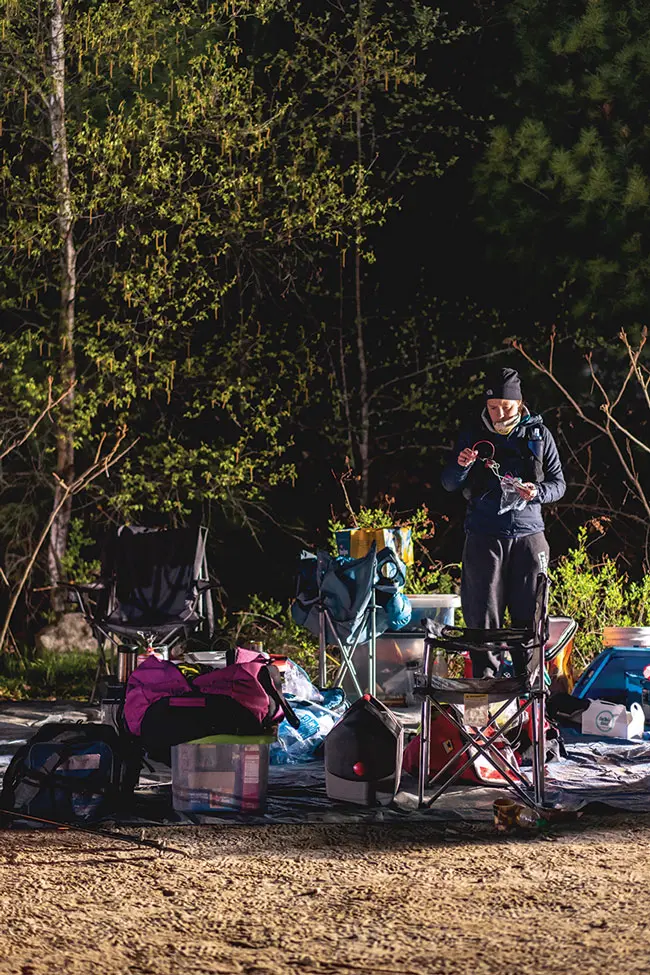
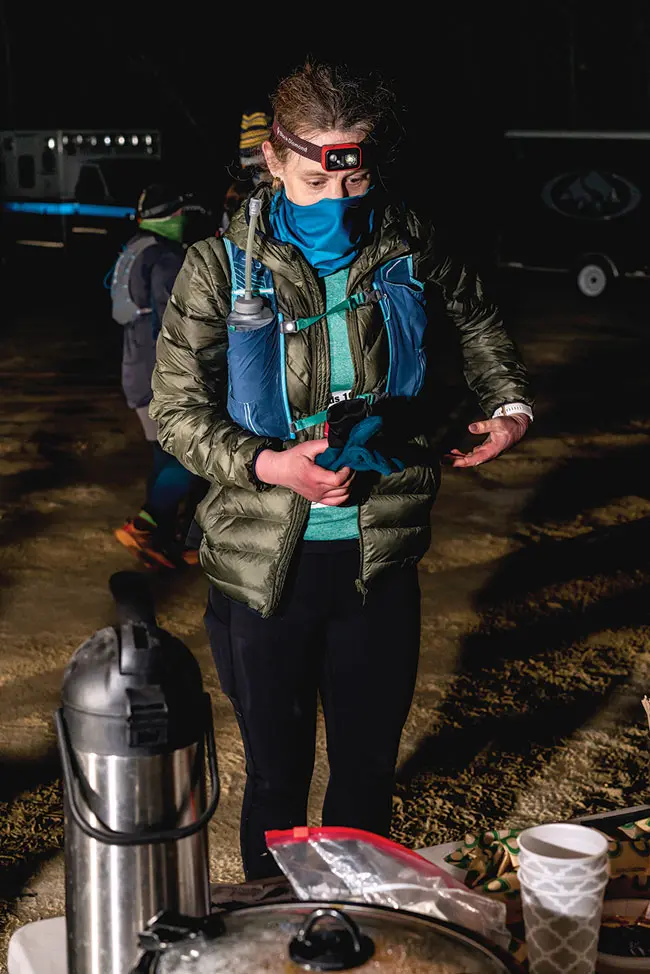
Abradi and Slovinsky have spent the past 20 hours cemented to their camp chairs in front of a portable folding table, dutifully recording as each runner completes a lap while also fielding calls from volunteers out on the course. As we chat, one aid station radios in to report they are out of pancake batter. Another is down to its last packet of American cheese. Word also comes in that a runner is vomiting bile somewhere on the course and needs to be brought in. Does anyone have a bead on that sick runner? And for the love of God, could someone turn off the ’80s power ballads?
The music quickly changes to the Violent Femmes. The driver of one of the side-by-sides offers to fetch the beleaguered runner and drop off both the cheese and the batter. Abradi contemplates a bathroom break, but before she can sneak off, a runner shuffles in, logging her 75th mile. The woman gimps past the directors’ table, pausing just long enough to ask if anyone has anything she could use to lance a blister on her heel. Several volunteers step forward with pointy objects.
“That’s the thing about ultras,” Abradi says. “You get to be a part of every single person’s race. There’s a real camaraderie in the shared misery and hopefulness.”
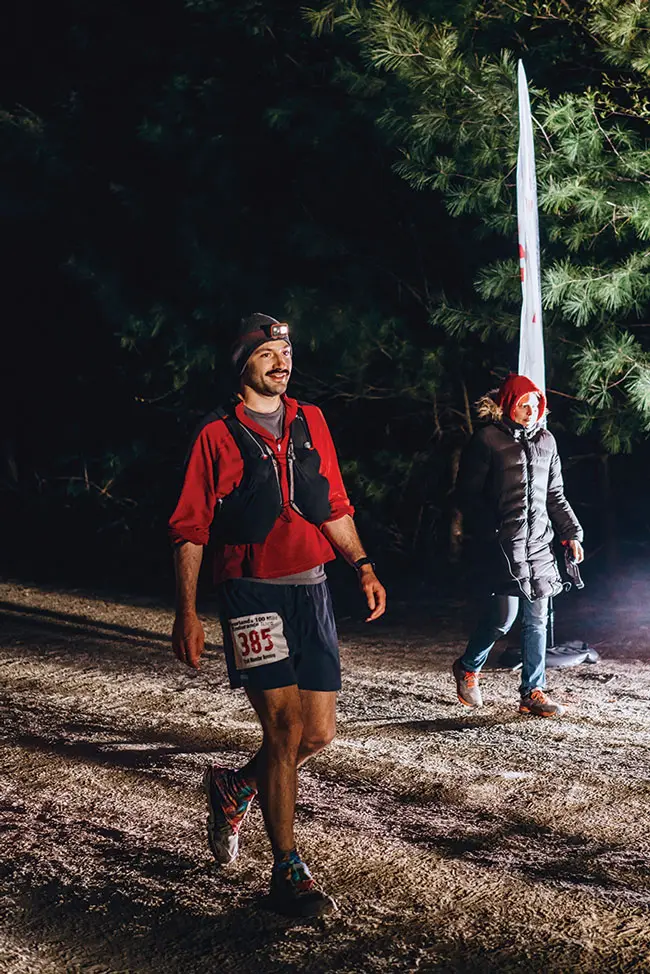
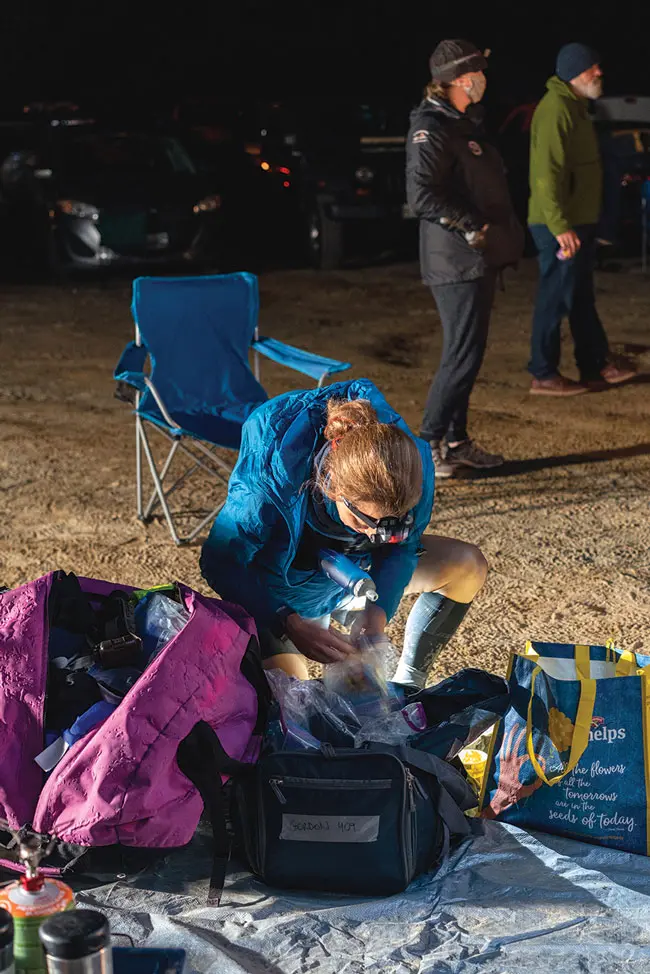
As lonely as those wooded, predawn miles seem, trail races are in many ways communal affairs. Runners help each other out, pacing one another, even alternating races in order to help their friends with logistics, gear, and food. Riverlands relies on a team of at least 50 volunteers, many of whom are runners themselves, who do everything from setting the course and grocery shopping to spending hours in the woods flipping pancakes and filling runners’ hydration bladders.
All this is typical of an ultramarathon anywhere in the country. The involvement of the UHV riders, however, is not. When Abradi and Slovinsky began scouting a race course, they couldn’t help noticing all the signs around Riverlands advertising the Turner Timberland ATV Club, the local organization responsible for maintaining many of the trails.
“We felt like it was their park, their territory,” Slovinsky says. So the two women showed up at one of the club’s monthly meetings. They introduced themselves and their vision for a race and asked if the riders might want to help.
To Turner Timberland vice president Brian Blanchard, it seemed like a natural fit. The family-focused club already had a history of organizing service projects, like benefit dinners and fundraisers for scholarships and families in need. “What these runners are doing is amazing,” he says. “It feels like a privilege to help.”
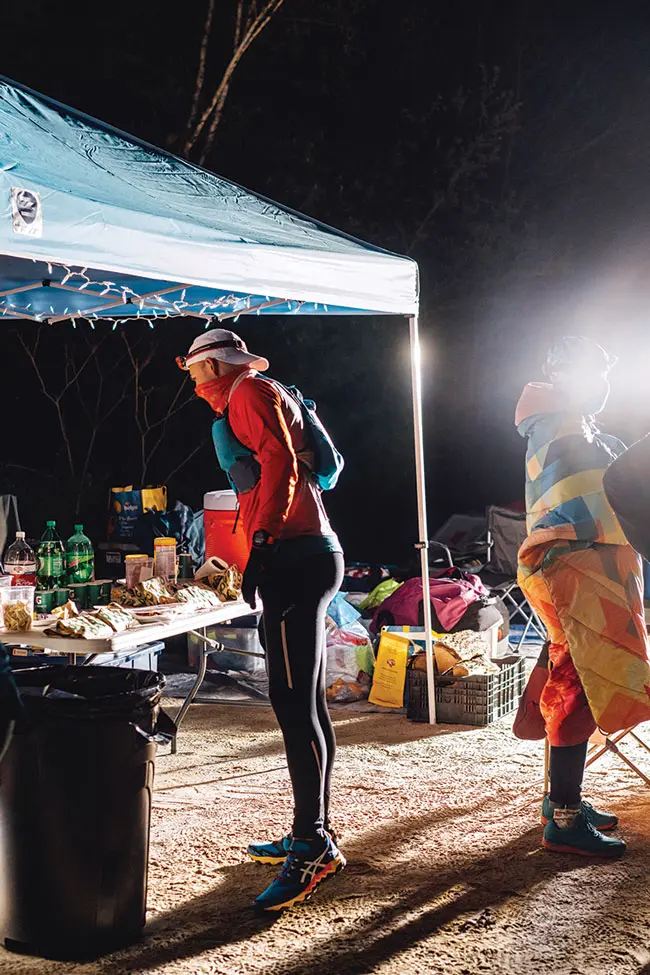
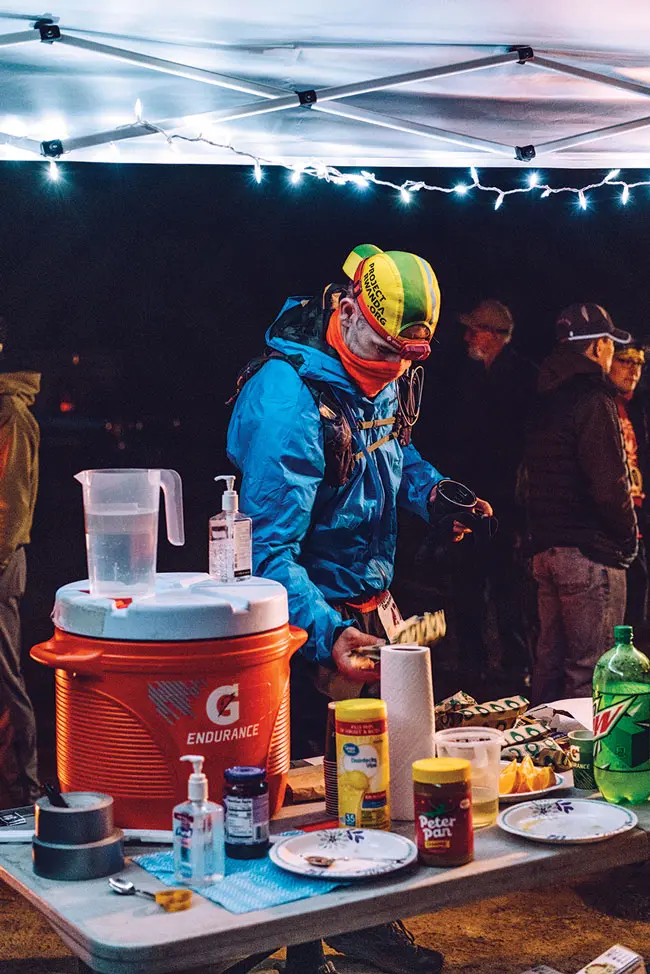
So members of the ATV club clear the trails in the weeks leading up to each race. Once it’s underway, they work around the clock to ferry supplies and volunteers to the aid stations and back, as well as to collect sick or injured runners. And over time, the runners and riders have grown chummy. Last year, runners from Trail Monster carved dozens of pumpkins for the ATV club’s annual Halloween ride, which benefits the group’s scholarship fund. “They’re family now,” Slovinsky says.
The Riverlands 100 course record is 17 hours and 37 minutes, set in 2019 by Utah-based Mark Hammond, one of the country’s top ultra runners. And while Abradi and Slovinsky say they’re glad the race draws such high-profile runners, they also want it to be approachable for everyone — at least, everyone who wants to run 100 miles in the woods — so they set what they thought were generous cut-off times for each lap. Contestants have 32 hours to finish, and some walk much of that time. Of course, the organizers concede, running 100 miles is never easy. And since the race is in mid-May, competitors are likely to face either residual snowpack or clouds of blackflies. Some years, only about half the field finishes in the allotted time.

Around 3:45 a.m. on Sunday, the first two finishers — Gordon Collins and Jay Frontierro — amble to the finish line, arm in arm. The two had never met before yesterday (Collins lives in nearby Poland; Frontierro in Gloucester, Massachusetts), but they’d kept each other company for much of the race. They each spent the last three miles offering to let the other finish first. In the end, Collins tells me, it just made sense to finish together.
“I don’t think either one of us could have pushed like that without the other,” he says. “We wanted a spectacular finish, so for the last mile, we locked hands and booked it to the end. It wasn’t preplanned, but it felt like the right way to honor the sense of community that really defines Riverlands.”


